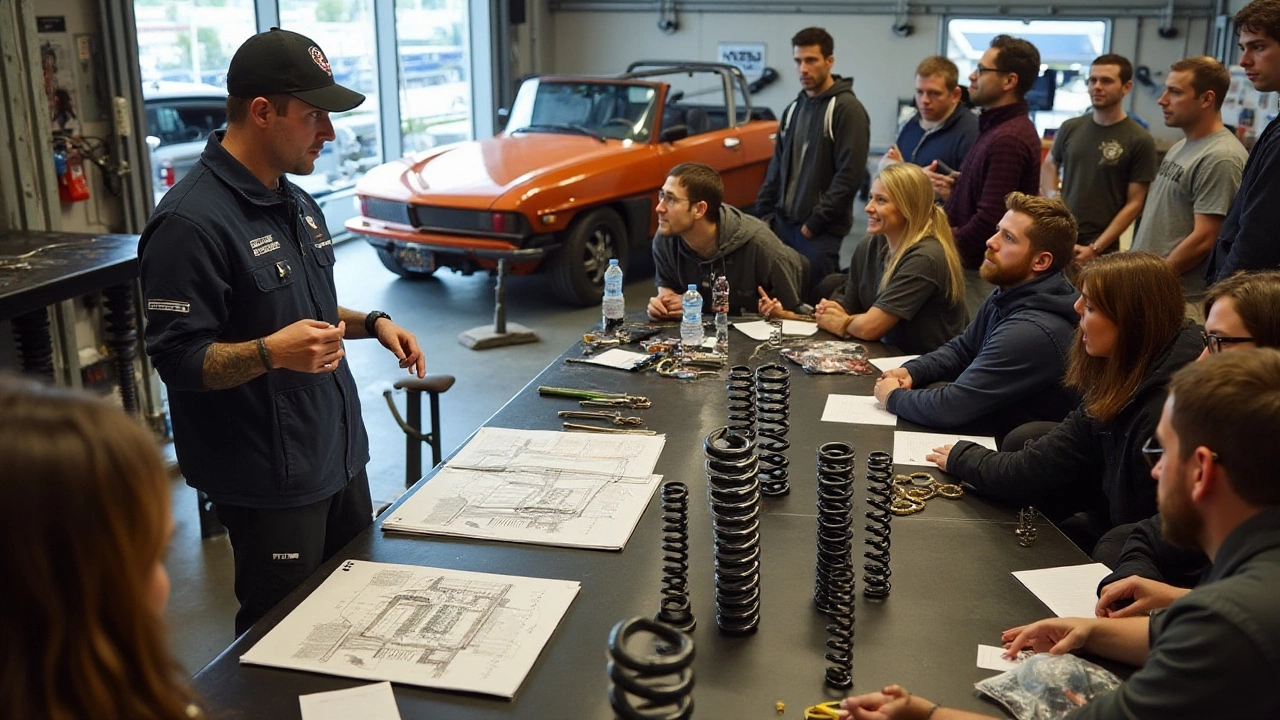Car enthusiasts often desire a sleek, lowered look for their vehicles, reminiscent of racing machines. While the thought of cutting springs to achieve that low profile might sound tempting, it's vital to understand the full implications of such a modification. Shortened springs can alter the dynamics of your car's suspension system, potentially leading to questionable handling and safety issues.
Before you embark on this journey with a saw in hand, it's essential to weigh the pros and cons. This isn't just about aesthetics; it's about performance and safety on the road. We'll dive into why some opt for this inexpensive modification and what generally happens when springs meet the cutting tool. But before you commit, consider exploring alternative methods that might provide the look you want without compromising your ride's integrity.
- The Appeal of Lowering a Car
- The Science Behind Cutting Springs
- Potential Risks and Downsides
- Alternative Methods for Lowering Cars
The Appeal of Lowering a Car
The allure of lowering a car often stems from its undeniable aesthetic appeal. Lower cars garner attention with their aggressive stance and streamlined look – a transformation that gives any vehicle a touch of flair reminiscent of high-performance race cars. The practice finds its roots in the racing world, where lowering a car serves an actual performance purpose, enhancing aerodynamics, and reducing drag to maximize speed. For the everyday driver, these changes may not yield significant speed advantages, though the visual transformation can certainly be captivating. As with many modifications, beauty lies in the eye of the beholder, and for car enthusiasts, a lowered vehicle represents sophistication and a personal touch.
Beyond the visual appeal, a lowered vehicle may offer drivers a heightened feeling of connection to the road. By reducing the distance between the car's body and the ground, many drivers report experiencing improved handling during corners and turns, as the center of gravity shifts lower. This can give the sensation of a tighter, more controlled ride, especially noticeable at higher speeds on open highways. While it must be noted that these benefits can significantly vary based on the driving environment and skill level of the driver, the allure of enhanced performance plays a crucial role in the decision to lower a car.
"Improving the looks and performance of a car through lowering has always been about achieving balance between form and function," remarks automotive expert and tuning legend, Larry Chen.
Enthusiasts often speak to the unique customization possibilities offered by lowering a car. In a world where many vehicles can blend into one another, the act of lowering can mark a car as distinctive, an extension of the owner’s personality. This type of modification is often one of the first steps in a broader landscape of car customization, marking an entry point into what could become a larger passion project. Lowering a car is not simply about technical performance – it's about an expression of identity on the road, and for many owners, this is reason enough to consider the option.
However, it’s important to point toward an unavoidable piece of the puzzle: the impact on the vehicle's practicality. For instance, navigating speed bumps, steep driveways, or uneven terrain becomes more challenging. As such, city dwellers may find their enthusiasm curbed when faced with the daily grind of pothole-ridden streets. This practical consideration is often weighed against the sharp appearance and potential handling benefits, making it a personal choice. While some are willing to pay the price for style, others may find the sacrifices too great.

The Science Behind Cutting Springs
At its core, the notion of cutting springs to lower your car revolves around one fundamental principle: reducing the height of the vehicle by shortening the coil springs in its suspension. When a spring is cut, its coil is effectively reduced in length, changing the way the suspension interacts with uneven surfaces on the road. The obvious visual impact is that it brings your car closer to the ground, giving it that aggressive, low-slung appearance car enthusiasts often crave. However, beneath this aesthetic transformation lies a complex interplay of forces and dynamics.
When you cut a spring, you alter its spring rate, which is the amount of weight required to compress the spring by one inch. Cutting shortens the coil, making it stiffer, which could result in a harsher ride because the suspension is less able to absorb road imperfections. This stiffness might enhance a car’s cornering ability at high speeds, a factor often prized in performance settings. But for everyday driving, it could mean every pothole and bump is felt more acutely inside the cabin. Here’s where the balance between performance enhancement and daily comfort often tilts unfavorably for those expecting an across-the-board improvement.
The material properties of the steel used in coil springs are meticulously engineered to handle specific loads and stress over millions of cycles. By cutting them, you not only change the fundamental geometry but potentially introduce stress risers which can lead to premature spring failure. This is especially critical in climates with severe temperature changes, as the constant expansion and contraction could exacerbate any existing weaknesses. Engineers often state that the springs undergo a precise heat-treating process to ensure uniform strength and durability. As stated by the World Automotive Society,
“Alterations to your suspension system should be approached with as much scrutiny as engine modifications. Your life might depend on how well your car navigates a surprise swerve or an unseen road hazard.”
One should also consider the economic implications. Although cutting springs can be a cost-effective method to lower your car, it might lead to unexpected expenses. Unwanted wear on other suspension components such as shocks and struts, if not calibrated correctly to handle the stiffer setup, can lead to expensive repairs in the long run. Calibration and balance adjust accordingly in professional tuning shops for a reason; when done on the street with improvised tools, accuracy suffers.
In some instances, the increased spring rate from cutting can enhance traction by maintaining more consistent tire contact with the road surface, yet it's a double-edged sword. Additional load stress on wheel bearings and tires can result in quicker deterioration if not matched with suitable upgrades. It’s worth noting that when short-cutting springs, the variability it introduces to the spring rates could lead to instability, especially under rapid directional shifts or braking. This instability could compromise safety, making any prospective speed-hungry driver think twice before letting impulse dictate their next move.
The overarching issue with cutting springs is predictability. While databases on specific spring types might suggest how the performance changes with one or two coil removals, achieving a precisely lowered ride height without the proper tools can be quite challenging. Each model of suspension reacts differently to modifications and involves variables that go beyond just the spring. Many countries' automotive standards stipulate how modified vehicles should be inspected to maintain roadworthiness, a critical procedure often overlooked by DIY modifiers. Hence, while tempting, cutting springs should be carefully considered against other professional options like manufactured lowering springs or coilovers, which still provide tunability and longevity.

Potential Risks and Downsides
The idea of lowering a vehicle by cutting springs seems cost-effective, yet it introduces an array of risks, which can turn thrilling rides into perilous drives. One of the primary concerns with cutting springs is the alteration of the car's factory-designed suspension geometry. The intricate balance engineers achieve when designing suspension systems to ensure optimal ride height, stability, and comfort isn't something that benefits from such DIY alterations. When springs are cut, they considerably lose their designed load capacity, leading the vehicle to rest closer to the ground than originally planned, which might seem fashionable but often results in compromised driving dynamics.
A cut spring will naturally exert a reduced force, impacting everything from damping rates to suspension travel. Insufficient suspension travel can cause harsh bottoming out over bumps, exacerbating wear on other suspension components. This stress can lead to expensive repairs and potentially dangerous situations when parts fail at the worst possible times. Speaking of potential dangers, handling characteristics are bound to change drastically. A low-cost reduction in height leads to increased sway and reduced shock absorption, especially when making sharp turns. This not only affects the control but can increase the risk of losing grip entirely, posing serious safety hazards for both drivers and passengers. As automotive expert Alex Simmons once noted, "When you cut corners on safety, you're not just risking material damage - lives are at stake."
The constant jarring and vibrations from an inadequately dampened suspension also extend their influence to other parts of the vehicle. The undercarriage components endure repeated stress, and body panels may experience additional vibration, potentially leading to annoying rattles or even structural integrity issues over time. Tire wear becomes uneven, necessitating more frequent and costly replacements as they endure more stress than they are designed to handle in a vehicle with modified ride height. Moreover, achieving a perfect cut on each spring becomes nearly impossible in DIY practices, leading to imbalances that can further damage the suspension system and diminish driving pleasure.
Legal and insurance-related pitfalls accompany these mechanical risks. Some jurisdictions strictly regulate vehicle modifications, and altering the suspension may fall afoul of these laws. Drivers risk fines or even invalidated insurance coverage, putting them in a precarious legal position if involved in an accident. While pursuing a stylish look, cutting springs without professional guidance can end up being a violation of road safety standards, implicating not just legal issues, but ethical concerns as well. All these considerations should prompt would-be modifiers to think twice or opt instead for professional lowering kits designed to maintain safety standards while fulfilling aesthetic desires.

Alternative Methods for Lowering Cars
Lowering a car doesn’t have to involve the risky business of cutting springs. There are numerous reliable and safe methods to achieve the desired look and feel of your vehicle. One of the most popular options is installing a set of high-performance lowering springs. These springs are engineered to maintain the integrity of your car's suspension system while reducing its height appropriately. They are designed to provide better handling by lowering the center of gravity, which can improve cornering abilities and reduce body roll. Properly installed lowering springs can also enhance the aesthetic appeal without sacrificing safety.
If you're looking to take things a step further, coilover systems offer an adjustable approach. With coilovers, you get the flexibility to tweak your car's height according to your needs. This setup combines springs and shock absorbers into a single unit, allowing for precise adjustments. Drivers who frequently alter their performance settings for different driving conditions often favor coilovers. It’s worth mentioning the initial cost may be higher, but the investment is justified by the significant improvement in handling and ride quality compared to traditional spring cutting.
Air Suspension Systems
For those who enjoy a balance of comfort and performance, air suspension systems provide a versatile solution. This modern method allows you to control the ride height of your vehicle at the touch of a button. It's particularly beneficial for enthusiasts who need the flexibility to navigate varying terrains and loading conditions. The installation of an air suspension system is typically more complex and can be more expensive upfront. However, the benefits of adjusting the ride height while keeping the vehicle performance intact make it an appealing option. An interesting fact is that many luxury car manufacturers have been incorporating air suspension systems to ensure a smoother ride for their customers.
Another approach worth considering is using a set of drop spindles. This technique involves replacing the stock spindles with ones that have a lower mounting point for the wheel hub. By doing so, the vehicle can be lowered while retaining the original spring and shock combination. This means you can keep your existing suspension setup, reducing costs and installation time. Drop spindles can be a perfect alternative if you're keen on maintaining the factory ride quality while achieving that elegant lowered flair.
"Car modification is about finding the right balance of style, performance, and safety," says renowned automotive engineer and enthusiast, Tim Harrison. "Opting for professionally designed systems like coilovers or air suspensions can make a significant difference in the long-term satisfaction of owning a customized vehicle."
Here’s a brief comparison of these alternative methods:
| Method | Cost | Adjustability | Installation Complexity |
|---|---|---|---|
| Lowering Springs | Moderate | Fixed | Simple |
| Coilover Systems | High | Variable | Moderate |
| Air Suspension | High | Fully Adjustable | Complex |
| Drop Spindles | Low-Moderate | Fixed | Simple to Moderate |
Whether you are pursuing aesthetics or performance, these alternatives to cutting springs provide better outcomes by supporting a balanced driving experience. Investing in quality products that come with verification and a warranty can ensure both safety and satisfaction. It's crucial to do proper research and consider professional advice before making any modifications to your car's suspension to ensure that you are making the right choice for your vehicle’s unique needs.






